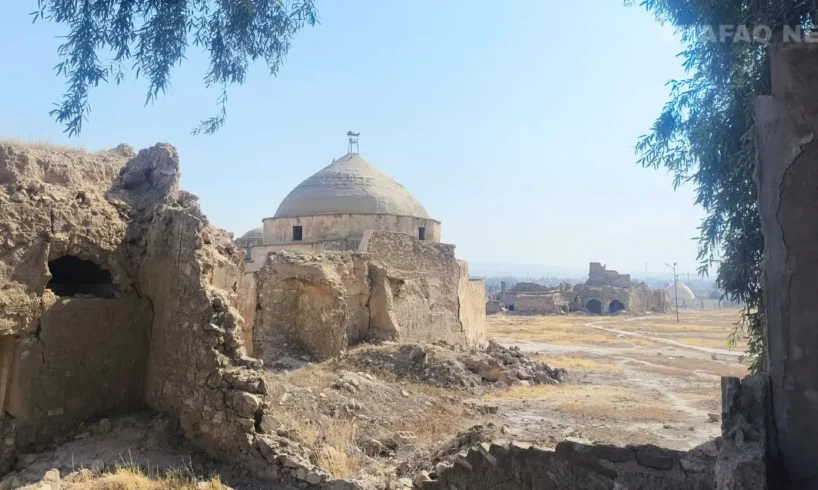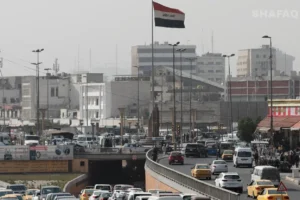
Shafaq News
Through the winding alleys of Kirkuk Citadel, where
centuries of dust and history linger in the air, a green dome rises above the
old quarter. Known locally as the Baghdadi Khatun Dome, the monument weaves
together legend, faith, and craftsmanship, standing as both a relic of Islamic
art and a testament to the city’s rich and layered identity.
The Green Dome ranks among the oldest landmarks within the
citadel. It dates back to the 14th century, specifically 762 AH/1361 AD, during
the Jalayirid dynasty, which ruled Iraq and western Iran from Baghdad after the
fall of the Mongol Ilkhanate — a period marked by a blend of Persian, Turkish,
and Mongol artistic traditions and a revival of Islamic architecture.
Historical records suggest that the shrine was built to
honor Baghdadi Khatun, a young woman who died in Kirkuk during a pilgrimage to
Mecca. Her father, a prominent figure of his time, commissioned the shrine to
preserve her memory. Some historians, however, believe the name may
symbolically refer to Baghdad itself, reflecting the capital’s political and
cultural prominence during that era.
Stone Survives
From the exterior, the Green Dome takes an octagonal form,
symbolizing the transition from the square of earth to the circle of heaven — a
motif deeply rooted in Islamic geometric design. Its façade was once covered
with Qashani, a square-shaped ceramic tile, in gradients of turquoise, cobalt
blue, and green, earning the shrine its enduring nickname: the Green Dome.
Inside, the shrine reveals a chamber embellished with
geometric patterns and Kufic inscriptions that reflect the precision and
artistry of 14th-century craftsmen. Archaeologists document that the interior
walls were once enriched with intricate stucco reliefs, merging Central Asian
motifs with Mesopotamian traditions to create a distinctive aesthetic.
“The design reflects a fusion of Mongol and Persian
influences,” explained Saad al-Din Mohammed, a restoration engineer
specializing in Kirkuk’s heritage. “Its decorations resemble those in the
shrines of Tabriz and Samarkand, with distinctive local touches using Kirkuk’s
traditional clay and gypsum.”
Mohammed noted that the structure comprises two levels: an
underground crypt believed to contain family burials, and an upper chamber
housing the main tomb. “The outer dome was once covered with glazed tiles, most
of which have deteriorated over time due to exposure and neglect,” he remarked.
Experts estimate the dome once stood about 10 meters high,
with an internal diameter of nearly six meters, giving it a compact yet
commanding presence over the citadel. The tilework, likely produced in
workshops in Baghdad or Tabriz, links the monument to other Jalayirid-era
landmarks, including the Tomb of Sheikh Safi al-Din in Ardabil and the
Soltaniyeh Dome in Iran.
Neglect Threatens Memory
Despite its historic and architectural significance, the
Green Dome now bears visible cracks and erosion. Its once-glazed tiles have
faded, and sections of the façade have fallen away under centuries of exposure
and neglect. The surrounding citadel is dominated by deteriorating buildings,
and parts of the site remain closed due to safety concerns.
“We used to visit it during the holidays to recite prayers,”
recalled Jabar Qadir, a longtime resident. “It was a place we loved since
childhood. Now it stands abandoned — the blue tiles that once sparkled in the
sun have mostly fallen off.”
A restoration effort launched by the Kirkuk Directorate of
Antiquities in 2018 was halted within months amid funding shortages and
administrative shifts. After that short-lived attempt, the directorate began
preparing a comprehensive new restoration plan under international supervision.
Officials indicate that the directorate receives less than
10% of the annual budget required to preserve Kirkuk’s heritage, which includes
more than 250 registered sites.
Today, over 80% of the citadel’s buildings are in varying
states of disrepair.
Broader challenges have further strained preservation
efforts. Iraq counts six UNESCO World Heritage sites in various parts of the
country — including Hatra, Samarra, Erbil Citadel, and Babylon — yet Kirkuk’s
citadel remains at the nomination stage, hindered by incomplete documentation,
structural vulnerabilities, and administrative obstacles that continue to delay
progress.
“The dome is a central feature of Kirkuk’s nomination file,”
highlighted Raed Akla, Director of Kirkuk Antiquities and Heritage, noting that
the directorate is preparing a new comprehensive restoration plan under
international supervision.
He also emphasized that the program would employ laser-based
documentation, 3D mapping, and moisture stabilization, following techniques
successfully applied at the Erbil Citadel, warning that any unplanned
restoration could threaten the monument’s authenticity.
Shared Devotion
Beyond its architectural value, the Green Dome carries
layers of legend and faith. The story of Baghdadi Khatun has long been
interwoven with Kirkuk’s collective memory — a tale of devotion and loss that
continues to endure through generations.
“Her story reflects love and fidelity,” remarked Muthanna
Abdulqadir, a heritage researcher. “Her father’s grief transformed into an
enduring monument — a story of parenthood and longing that still lives in the
city’s folklore.”
Over time, the shrine became a shared spiritual refuge for
Kirkuk’s diverse communities. “People from different religions once visited the
dome for blessings and prayers — Muslims, Christians, even Jewish families
before the mid-20th century,” Abdulqadir noted, emphasizing that it stood as a
rare expression of unity and reflected the city’s inclusive character.
Residents recall how visitors would light candles, tie
ribbons to the iron gate, or leave offerings of flowers and sweets — simple
gestures of devotion blending Islamic and folk traditions. During festivals,
particularly Eid al-Fitr and Eid al-Adha, the shrine served as a gathering
point for collective remembrance.
Before partial closures, the citadel attracted thousands of
annual visitors, mostly domestic tourists and school groups. Preservation
advocates believe that restoring the site could help revive cultural tourism
and create jobs for local artisans and heritage experts.
Despite its scars, the Green Dome remains a reflection of
the city’s enduring soul — a quiet survivor of time, memory, and devotion.
Written and edited by Shafaq News staff.





